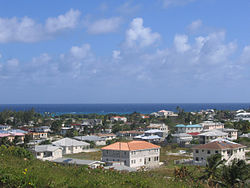Christ Church | |
|---|---|
 View of Christ Church, 2008 | |
 Map of Barbados showing Christ Church | |
| Coordinates: 13°05′N 59°32′W / 13.083°N 59.533°W | |
| Country | Barbados |
| First settlement | 1627 |
| Independence | November 30, 1966 |
| Largest city | Oistins |
| House constituencies | 5
|
| Government | |
| • Type | Parliamentary democracy |
| • Parliamentary seats | 5 |
| Area | |
• Total | 57 km2 (22 sq mi) |
| Population (2010 census) | |
• Total | 54,336 |
| • Density | 950/km2 (2,500/sq mi) |
| Time zone | UTC-4 (Eastern Caribbean) |
| Area code | +1 (246) |
| ISO 3166 code | BB-01[1] |
The parish of Christ Church is one of eleven historic political divisions of Barbados. It has a land area of 57 km2 (22 sq mi) and is found at the southern end of the island. Christ Church has survived by name as one of the original six parishes created in 1629 by Governor Sir William Tufton.
The parish contains the Sir Grantley Adams International Airport as well as the last remaining mangrove swamp in the country, the Graeme Hall Nature Sanctuary. Under Barbados's historic vestry, the main parish church was originally seated near Dover. After it and the courtyard were destroyed by flood in 1669, the main parish church moved to Oistins area, becoming the main town and former capital of the parish. The South Point Lighthouse is located in South Point, Christ Church, between Atlantic Shores and Green Garden, also in Christ Church.
Another notable area of Christ Church is Saint Lawrence Gap, which is the most lively tourist area on the island. Many of the taverns and clubs in St. Lawrence are frequented by locals and tourists alike.
- ^ iso:code:3166:BB, International Organization for Standardization